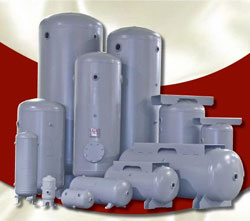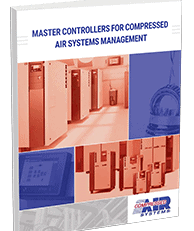How to Size a Compressed Air Tank
Comments Off on How to Size a Compressed Air TankCompressed air tanks, often referred to as air receiver tanks, are a vital part of all compressed air systems. They help balance the supply of air from the compressor with the demand from the system by acting as a reservoir during peak times. Additionally, they can remove water from the compressed air system and minimize system pulsations.
Achieving the maximum benefits from an air receiver tank necessitates choosing one that is properly sized for the compressed air system. In most cases, a receiver tank is sized at 2 gal/scfm. However, if big surges in demand are expected, the size is increased to between 4 and 10 gal/scfm. The following article goes into further detail about what an air receiver tank is, why it is important, and how to properly size one for a compressed air system.
What Are Air Receiver Tanks?
Air receiver tanks are engineered to temporarily store compressed air before it enters equipment or a piping system. They help connected compressed air systems operate efficiently during operations by acting as a buffer between the compressor and fluctuating buffer. Additionally, they can be used to supply additional air to the system to accommodate surges in demand and/or run the system even when the compressor is not running.
Compressed air systems use two types of air receiver tanks: primary and secondary. Primary tanks are located close to the air compressor system and act as air storage devices. Secondary tanks are located further from the compressor system while still being accessible to any device that requires air.
Why Are Receiver Tanks Important in Compressed Air Systems?
While it is technically possible for a compressed air system to function without a receiver tank, there are several reasons why they are a vital component of highly effective systems. First, they serve as reservoirs that supplement compressed air supply during peak demand. Second, they remove water that might be present in a compressor system by cooling the air. Third, they decrease the amount of pulsations experienced by the system.
Some of the key factors to consider when choosing a receiver tank for a compressed air system are:
- Size: An air receiver tank should be sized between 6–10 times the flow rate of the system. For example, compressors with a rating of 25 scfm at 100 psi should have a tank that is size at a minimum of 150 cubic feet.
- Working Pressure: Air receiver tanks must be fitted with a pressure relief valve and pressure gauge. The former should be set to 10% above the working pressure of the compressed air system.
- Drainage/Drying elements: A drain enables the receiver tank to expel water from the system. It can be manual or automatic. The inclusion of an air dryer and coalescing filter can further help improve the dryness of the compressed air.
How to Properly Size an Air Receiver Tank
 Air receiver tanks are sized in terms of volume (measured in gallons). They are available in sizes ranging from 5-gallon capacities to several thousand gallon capacities. It is important to choose the size based on the needs of the application. Key considerations to keep in mind include:
Air receiver tanks are sized in terms of volume (measured in gallons). They are available in sizes ranging from 5-gallon capacities to several thousand gallon capacities. It is important to choose the size based on the needs of the application. Key considerations to keep in mind include:
- Capacity: How much air can the air receiver store? It should be greater than the amount of air required for the application.
- Pressure: What compressor discharge pressure is required? What end-use pressure is required? The greater the difference between the two values, the smaller the receiver needed.
- Time: How much time (in minutes) does the tank take to supply the amount of air required without a significant drop in pressure?
- Air requirement: How much air does the end-user require to operate at optimal capacity?
In addition to these factors, sizing a receiver tank can vary depending on the compressor design.
Sizing a Compressed Air Tank for Reciprocating Air Compressors
Reciprocating air compressors rely on a receiver tank to store compressed air and eliminate pulsation before it is used for operations. When the tank is filled with enough compressed air, the connected device can be operated. Using the device drains the tank, so users will need to wait for it to fill back up if it is emptied before the device can be used again. Correctly sizing the air receiver tank to the compressor helps minimize interruptions by eliminating the risk of it emptying before the task is done.
Sizing an Compressed Air Tank for Stationary Air Compressors
Custom stationary air compressors utilize air receiver tanks that are more complex to size correctly. As a result, sizing should generally be performed by a qualified engineer. Factors influencing tank sizing include volume and pressure variations in demand, air compressor size, pipe/hose size and length, and control system.
Contact Us for Tank Sizing Help Today
Need help determining the right air receiver tank size for your system? Ask the experts at Compressed Air Systems! We offer high-quality air receiver tanks for various compressed air system needs. Our engineers can help you evaluate your system requirements and restrictions to identify the best tank solution.
How to Reduce Pressure Drop in Your Industrial Compressed Air System
Comments Off on How to Reduce Pressure Drop in Your Industrial Compressed Air SystemCompressed air systems can develop instances of pressure drop throughout their lifespans, disrupting productivity and leading to inconsistent performance. However, with the right maintenance schedule, parts, and monitoring processes, businesses can minimize the risk of system pressure drop and reduce unscheduled downtime and performance inconsistencies. Learn more about the common causes of pressure drop, how your team or repair technicians can reduce pressure drop, and the benefits of a proactive approach.
What Causes Pressure Drop?
Maintaining a stable pressure level in a compressed air system requires an unobstructed closed loop or connective hose through which pressurized air can travel at a steady rate. Any changes to this environment, such as loose parts, obstructions within the system, and rough internal surfaces, can disrupt the flow of air. Disruptions to steady air compressor pressure come from two major categories:
- Problems with air quality components which include air/lubricant separators, moisture separators, aftercooler components, filters, and dryers.
- Problems with the distribution components, such as the tubing, couplings, hoses, pipes, or regulators.
A pressure drop may register when the compressor delivers insufficient air because of blockage, leaks, or other interruptions. This lowers the pressure within the system, and the compressed air regulation systems respond accordingly. The pressure changes can also result in a lot of wasted energy; in fact, this energy waste increases exponentially as the pressure conditions exceed the recommended pressure levels. If technicians notice restricted air flow within the system or changes in pressure levels that the system must accommodate, it’s time for an inspection or maintenance.
How to Reduce Pressure Drop
While it’s impossible to eliminate pressure drop within an industrial compressed air system entirely, it is possible to significantly reduce the risk and severity of any pressure drops. Frequent inspections, ongoing monitoring, and preventative maintenance can help your facility catch problems early on and prevent them from growing too large. Follow these steps to reduce pressure drop:
1. Inline Filtration
An inline air compressor filter is a device that is installed in the air line between the compressor and the point of use. It is designed to remove contaminants, such as dirt, rust, and moisture, from the compressed air before it is used. This helps to protect the equipment and tools that use the compressed air, and can also help to improve the quality of the finished product. Inline air compressor filters typically use a filter element made of paper, metal mesh, or synthetic media to remove the contaminants. They are also made in different size and flow rate, depending on the compressor and the application.
An inline air compressor filter can reduce pressure drop by using a filter element with a high dirt-holding capacity, a large filter surface area, and a low resistance to airflow. A high dirt-holding capacity means that the filter element can trap a large amount of contaminants before it becomes clogged, reducing the need for frequent filter replacement. A large filter surface area allows for more contaminants to be trapped, while also allowing for a higher airflow rate. A low resistance to airflow means that the filter element does not impede the flow of air too much, reducing the pressure drop across the filter. Changing the filter elements on a frequent basis will help keep the pressure drop low.
2. Inspect the Tubing
Tubing is a common source of problems that cause pressure drop. Loose fittings at the ends of the hoses, harsh bends in the hose, and even developing wear or holes can lead to pressure drop. The internal surface of the hose, especially if it’s rough or abraded, can interfere with pressure. Regularly check the tubing to ensure it’s airtight throughout its length and at any fittings. Look for cracks, detectable airflow, and rust formation (which can indicate developing damage and vulnerability).
3. Check for Any Worn Hoses
Examine hoses for leaks, especially developing leaks that may escape casual notice. Also, ensure hoses are arranged with as little external stress as possible.
4. Consider the System Connections
Connectors, valves, and other components should be tightly fit into place and in good condition without rust or cracks. Also, facilities with overly complex systems that have multiple connectors will benefit from a simplified system with fewer failure points.
5. Check the Regulators
The pressure regulators may be faulty and cause pressure drops without any damage to the actual system. Prevent air compressor regulator pressure drop by resetting the regulators and ensuring they’re taking accurate readings.
6. Check the Lubricators
It may be time to replace lubricators within the compressed air system to maintain the right flow rate.
The Benefits of Reducing Pressure Drop
Pressure drop poses a real risk of inhibiting high-quality performance and wasting a lot of energy. Consider these benefits of addressing and reducing pressure drop:
Improve System Performance
Boost your pneumatic system’s performance by stopping leaks and pressure drop. Your employees can use the compressed air system more efficiently, with fewer delays and errors. Completely addressing pressure drop issues can also reduce unscheduled downtime and costly parts replacement.
Reduce Maintenance and Unscheduled Downtime
Unplanned maintenance and repairs are expensive. Not only does your facility have to pay emergency rates, but you lose production hours. This can put you behind schedule or force you to pay SLA fees. But proactive monitoring and maintenance ensure you catch problems in a timely manner. The problems are smaller, less expensive to repair, and faster to resolve. Investing in newer or more resilient equipment can reduce downtime even more.
Lower the Operating Costs
Pressure drops, as well as the potential gaps and leaks causing the pressure drop, leads to higher operating costs and wasted energy. Addressing the problem reduces operating costs on a day-to-day basis. For every 2 PSIG pressure drop equals one percent less energy. Lowering your plant pressure 10 PSIG gives you a five percent energy savings.
Reduce Facility Emissions
Decreasing energy usage also has the broader effects of reducing your facility’s carbon footprint and energy waste. You will reduce your facility’s overall generation of greenhouse gases.
Start Reducing Pressure Drop With Support From Compressed Air Systems
Pressure drop is expensive, wasteful, and potentially damaging to your production levels. But resolving pressure drop with maintenance and monitoring is simple, cost-effective, and better for your company’s ESG goals. Turn to Compressed Air Systems for support in repairing, maintaining, and improving your compressed air systems. Contact us today for more information.
5 Ways a Blower and Vacuum Pump Can Help With Your Production
Comments Off on 5 Ways a Blower and Vacuum Pump Can Help With Your ProductionIndustrial blowers and vacuums help regulate airflow in warehouses, factories, and other production facilities. One common application of blowers and vacuums is cleaning—using air to remove debris, dirt, water, and other contaminants. They also remove stale and contaminated air from industrial settings. But compressed air blowers and vacuums can serve other purposes, too.
Here are five ways a blower and vacuum can help with your production.
Applications of Blowers and Vacuums
Nitrogen Blanketing/Modified Atmosphere Packaging (MAP)
Modified atmosphere packaging (MAP) technology helps extend the shelf life of fresh food. It involves removing the atmospheric air inside a package and replacing it with a protective gas mix. This gas—usually consisting of nitrogen—maximizes the freshness of the product.
Though both MAP and vacuum packaging require compressed air and vacuum pumps, MAP differs because it doesn’t always have to remove oxygen from the packaging. Instead, MAP involves adjusting oxygen and carbon dioxide levels within the package to the required values. The vacuum pump makes the final seal to ensure the gases remain intact in the container.
Filling and Closing Machines
Vacuum systems have a pivotal role in the beverage industry. They help evacuate air and other contaminants to ensure consumers receive quality goods. Vacuuming also prolongs the shelf life of various products. Filling and closing machines use vacuum systems to seal:
- Alcoholic drinks
- Bottled water
- Juices
- Sports drinks
- Nutritional supplements
Bottle Filling
The oxygen content in bottled beer must be kept low. That is why breweries employ different bottle-filling methods. They may flush the bottles with CO2 and fill them with beer using a long tube filler. However, this method uses a significant amount of CO2. Another method involves evacuating the bottles and flushing them with CO2, which minimizes CO2 consumption.
Packaging
Vacuum systems have a critical role in packaging. Generally, the pressure around a product has a mechanical impact on the product’s external shape. Therefore, the modified atmosphere packaging process is an ideal method across many applications, including food and beverage, pharmaceutical, and cosmetics processing. By packaging products in a modified atmosphere and removing oxygen, MAP encloses the product in a blister package, places it in a vacuum chamber, and evacuates it. After injecting it with the modified atmosphere, the package is sealed with a protective film.
Dairy Processing and Milking
Yogurt-filling machines require a vacuum pump to position the lids on multiple pre-filled yogurt containers at once. The machines have suction cups that pick up the lids, separate them, and place them in the right positions.
Milking systems have vacuums that attach to the cow udder and transport the milk. Compared to conventional oil-lubricated pumps, side channel blowers and liquid ring pumps do not use oil and thus have fewer maintenance needs. Side channel blowers in particular do not need water connections and are available with frequency converters.
Get the Right Blower and Vacuum for Your Application
Compressed air blowers and vacuum pumps are valuable devices that enhance or, in many cases, enable production. High-volume blowers and vacuum pumps are available in different varieties, so Compressed Air Systems is here to help you choose the right system(s) for your commercial or industrial application. Contact us today to learn more about our products and services.









